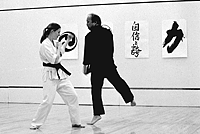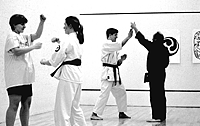

It's a lot like dancing. Or so one how-to book says about Aikido, a popular Japanese martial art found in Hales Gym throughout the week.
Between 30 and 40 people are involved with the Aikido ExCo, "but that many people don't show up all the time," senior Alex McCarthy, leader of one ExCo session, said.

"In Aikido, you focus on your structure, your balance," McCarthy said. McCarthy's passion for the art was obvious with his book collection on the subject. One page proclaimed, "The purpose of conflict is harmony."
Like many martial arts, Aikido is primarily defense-oriented. Use of weapons, including a stick called a bokken, is permitted but not a focus.
McCarthy quoted Mitsusi Saotome, the primary sensei in the United States in his explanation of Aikido. "Aikido is living. Aikido is living in the life."
The Aikido group has been in Oberlin for just under 30 years. McCarthy said the national Aikido community is laced with Oberlin alumni. "The Oberlin Aikido club was the first in the country to invite [Saotome] as an instructor," McCarthy said.
When asked why he thought martial arts were so popular at Oberlin, McCarthy said, "Well, there's not much else to do."
Seriously, though, McCarthy said, "Martial arts fits right into what the typical Oberlin student is. People want to be athletic but want more out of it than just being a jock."
The Aikido community also helps to keep people coming back. "I've met some incredible people. That's why I stay in Aikido," McCarthy said.
Ninjas at Oberlin? Well, sort of.
The Bujinkan club meets three times a week and is one of the more mis-understood martial arts here. "We're made up of nine different schools. Some in Taijutsu and some samurai and some aren't really anything," senior Jason Meyer who runs the ExCo, said. "It's all blended together."
The Bujinkan club is referred to by some as the Ninja martial art. "I can't really dispute it," Meyer said of the common terminology. "Three of the schools included are the only surviving forms," he said.
The focus of the Bujinkan club is unique in the Oberlin martial arts realm. "Our main focus is being able to survive. We work on being able to survive an ambush," Meyer said.
The ExCo numbers are smaller than others, tolling only about 12, but Meyer said that is all the number they can handle. "We do a lot of dangerous things. We don't get many injuries at all, though." He explained the paradox by saying that each person was focused on individual responsibility.
The group is not as traditionally based as the other common martial arts. "We try to keep it pretty family-style," he said. This varience from the others has created some slight rifts in the martial arts community at Oberlin, but Meyer thought the rifts were deeper elsewhere. "I get random insults from the Aikido club, but compared to what I've had at other places, this is ideal," Meyer said.
The philosophical background of the Bujinkan club is not as well defined as Tae Kwon Do. "You can't really understand the kind of philosophies we have unless you have that hands-on connection," Meyer said about the focus on the physical aspects of the ExCo.
With one hand opened in welcome and the other raised in defense, the Karate Club's emblem of a water goddess embodies their philosophy.
This vision came to Misugami Shintu, the Karate instructor in a dream and plates the front of the Karate club's uniform.

Over 30 people are in the Karate club and ExCo, and this interest is primarily new. Over 20 people are beginners taught by one of a handful of student instructors during the week.
"We are the club of wacky escapades," senior Jen Skarda, a leader of the beginner ExCo Karate class said smiling. Included in those escapades was a winter training exercise where the team had to stand behind a frigid water fall. "All the rest of our funny stories involve people getting hurt. Or almost getting hurt," Skarda said.
The class was over-run with enthusiasm last Wednesday, while the sensei joked with those he sparred with. "Your shoe is untied," he said. "Your zipper is down."
The sensei demonstrated his excellent technique with the intermediate/advanced class. At the end of each student's turn, the sensei and student shake hands and bow.
"Our style is based on natural body movement and is very self-defense oriented," Skarda said.
"EEE-AWWW!" came from the sensei from a student's kick. "See, when you get hit, you have to grimace," Shintu said kiddingly.
Skarda further described Karate. There is some debate about its origins. "Some say that it spread through wandering monks. Other say it spread though brawling sailors it bars," Skarda said. The style is a mix of Chinese martial art and wrestling.
"It's great fun. We're here three to four nights a week," senior Josh Gepner said.
The ExCo course allows accessibility to Karate for about 30 people. "I've been amazed at martial arts activity on campus. I think that's because a lot have done stuff before [they came to Oberlin]," Skarda said.
Gepner is currently working on a martial arts film. "It deals with a courageous student attempting to get a CAN number," he said.
Tae Kwon Do and aerobics share two things: they both have an "ae" and both burn a lot of calories.
Tae Kwon Do is a Korean martial art that involves mostly kicks. "All the kicks you see in martial arts movies are us," Kwangmin Rhee said. Rhee teaches the Tae Kwon Do ExCo. Rhee said the ExCo attracts about 40 people to the first class and about 20 to 25 end up staying.
"I have a very large core group right now," Rhee said.
Rhee has been learning the art for about 15 years. "I learned it outside of school. The instructor was a friend of my father's. The schooling I attended was very, very formal. At Oberlin, it's a little more relaxed, but not too bad."
Alex McCarthy, president of the Aikdo club complimented the Tae Kwon Do group on their dilegence. "I have a lot of respect for Tae Kwon Do. They are in great shape," McCarthy said.
The link between Tae Kwan Do and other martial arts at Oberlin is limited. Rhee acknowleged personal links with instructors of other martial arts, but said, "We're pretty much on our own."
Rhee said the martial arts were difficult to explain because, "They all have a million aspects to them. If Rhee wanted to teach them all, he would be teaching all day everyday. "I just try to make my people work hard," Rhee said. "We mostly focus on cardiovascular excercise."
Like any sport, different people have different affinities towards Tae Kwon Do. "Some are so bad, you just shake your head. Many who have taken dance have an affinity. If you're naturally athletic, then it comes easy to you."
John Talbert has been teaching the Tai Chi ExCo for ten years. He described the Tai Chi martial art as the yin part of martial arts. "The emphasis is on relaxation and posture. You try to make your movements efficient," Talbert said.
The Chinese martial art is focused on philosophy and is strongly connected to Taoism. "A legendary figure started it after watching a snake and a crane fight. Each fought for hours but could never get at each other. Finally they tired each other out," Talbert said. So Tai Chi is meant to train the student to be fluid and "able to receive force when it comes to you and then release it."
The beginning ExCo class has about 25 people. Of those, Talbert said he has a core group of about five who continue through the semesters.

Talbert postulated that the mental exercise involved in martial arts was one of the features attractive to Oberlin students.
"We'll learn a movement and then we'll describe applications and ways to make it comfortable which automatically refers back to the philosophy of life," Talbert said. "It's a really absorbing physical activity."
Talbert suggested that martial arts be made a major at Oberlin. "I mentioned it to a few of the coaches and got absolutely no reaction. It's not just fighting. That's just the half of it," Talbert said.
(Top) "Your shoe's untied": Senior Jen Skarda spars with the sensei as he tries to divert her attention.
(Middle) Martial Law: Two members of the intermediate/advanced Karate class practice on the Philips squash courts Wednesday.
(Bottom) Counting off: Karate students do a short drill.
Copyright © 1998, The Oberlin Review.
Volume 126, Number 15, February 20, 1998
Contact us with your comments and suggestions.